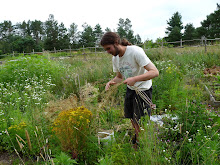Friday, October 21, 2011
The Peanut Harvest
Wednesday, August 24, 2011
Two upcoming events at the farm!
We're pretty excited to be organizing a couple of events at the farm in the coming few weeks. A seed saving workshop and then the much anticipated Tomato Fest. Hope you can make it out for one or the other!
-Seed Saving Workshop - August 31, 2:00 to 5:00 pm at Annapolis Seeds - Come learn the basics of saving seeds! As we tour through the Annapolis Seeds gardens we'll discuss seed saving techniques for many different vegetables, from the easy ones like beans to the trickier ones like the brassicas. Hands-on demonstrations too! We'll practice simple and low-tech threshing and seed cleaning techniques. We'll be covering all the basics but discussions will be guided by your interests, so more advanced techniques can be covered too. Cost: $25 - $40 for couples - or pay what you can. Contact me at owen@annapolisseeds.com or 902 825-0553 to register
-Tomato Fest - September 11, 12:00 to 5:00 pm at Annapolis Seeds - Come celebrate the tomato! Experience the incredible diversity of heirloom tomatoes that you simply can't find in the supermarket. We'll have about 100 varieties on display and for tasting... you'll be able to vote for your favourite! Guided farm tours will be throughout the day and we'll have workshops on growing great organic tomatoes and saving tomato seeds. More info to come... Cost: Free! Although donations will be welcomed
Saturday, July 30, 2011
Threshing Techniques, Part 1 (Threshing Bag)






Tuesday, July 12, 2011
3rd New Farmers Gathering, June 11-12






Wednesday, April 20, 2011
Seed Stories Video
Monday, April 18, 2011
Middleton Seedy Friday, April 29
Tuesday, April 5, 2011
Our New Propagation Greenhouse




So the whole project took an afternoon to assemble and cost about $80 using new supplies, not bad considering how many hundred of plants it'll grow! The mini-greenhouse itself was an old one we had kicking around in the barn, it wouldn't be hard to rig up something similar using perhaps PVC pipes or whatever you have handy.

